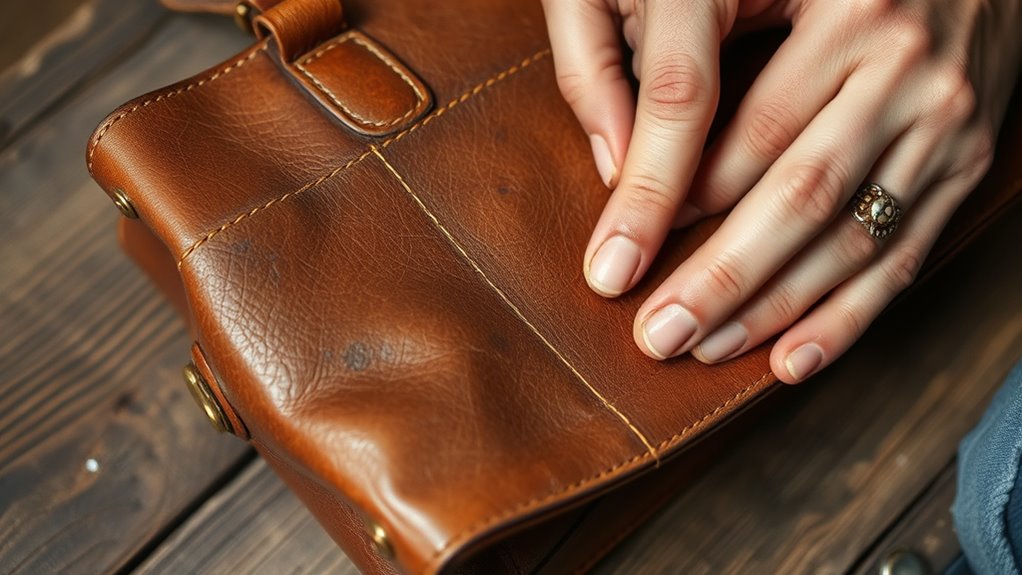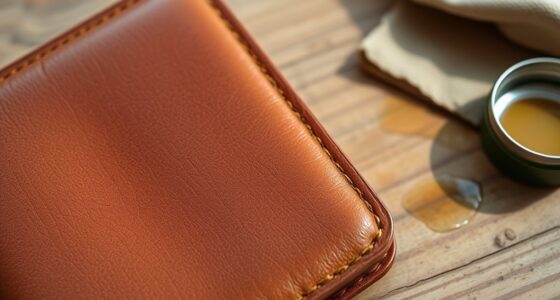When deciding whether to repair or replace your bag, consider its sentimental and monetary value, age, and condition. If the damage is superficial, works with quality craftsmanship, and preserves your bag’s charm, repair is often worth the investment. However, extensive wear, low value, or outdated style might make replacement more practical. If you want expert tips on making the right choice and ensuring a successful restoration, keep exploring these key factors.
Key Takeaways
- Consider the extent of damage; superficial issues are often worth repairing, while extensive deterioration may warrant replacement.
- Evaluate the bag’s age, rarity, and sentimental or monetary value to determine if restoration preserves its worth.
- Compare repair costs with the price of a new bag, factoring in long-term durability and craftsmanship preservation.
- Prioritize professional restoration for high-quality materials and craftsmanship to ensure effective, authentic results.
- Opt for sustainable choices; repairing extends lifespan, reduces environmental impact, and may be more cost-effective than replacement.
Assessing the Extent of Damage and Wear

Before deciding whether to repair or replace, you need to accurately assess how much damage or wear the item has sustained. Look closely at the material deterioration—are the leather or fabric scuffed, stained, or cracked? Check for aesthetic damage like fading, scratches, or loose stitching that impacts the bag’s appearance. Determine whether the damage is superficial or if it affects the structural integrity of the bag. Small tears or worn edges might be repairable, while extensive material deterioration or significant aesthetic damage could mean replacement is more practical. Be honest about the extent of the damage; understanding how much wear your bag has endured helps you decide whether a professional repair can restore its look and function or if it’s time to think about a new purchase. Evaluating the material quality can also help determine whether repairs will be durable or if the damage indicates the bag’s overall decline.
The Value of Your Handbag: Sentimental and Monetary Considerations

Your handbag often holds more than just your belongings; it can carry significant sentimental and monetary value. A luxury branding piece may remind you of special moments or represent a milestone, making its preservation worthwhile. Fashion trends can also influence its worth, as classic designs tend to hold or increase their value over time. Restoring a high-end bag helps maintain its desirability and aligns with current trends, ensuring it remains a stylish statement. Additionally, if your handbag is a limited edition or vintage piece, its monetary worth can appreciate with proper care. Recognizing these sentimental and monetary considerations helps you decide whether professional restoration is a smart investment, preserving both its emotional significance and market value. Advances in AI technology are increasingly used to assess the authenticity and condition of luxury items, aiding in preservation decisions.
Cost-Benefit Analysis of Repair Versus Replacement

When deciding whether to repair or replace, you need to compare the costs and benefits of each option. Consider which choice offers better long-term value and fits your budget, keeping in mind repair limitations and advantages. This analysis helps you make a practical decision based on efficiency and overall savings. Additionally, understanding expert advice on evaluating the true condition of items can guide you in making more informed choices.
Cost Efficiency Comparison
Deciding whether to repair or replace a failing bag hinges on a careful cost-benefit analysis that balances upfront expenses against long-term savings. Repairing a high-quality, luxury branded bag often preserves its resale value and maintains its exclusivity. Conversely, replacing it might seem simpler but can be costly and diminish its luxury branding appeal over time. Consider these factors:
- Repair costs versus new bag price
- Impact on resale value and brand perception
- Durability and longevity post-repair
- Potential for restoring original craftsmanship
- Long-term savings through maintenance
- Choosing preppy dog names that reflect timeless style can also inspire your decision to restore or replace an item.
If your goal is to maximize value and uphold luxury status, investing in professional restoration can be more cost-efficient in the long run. It preserves the bag’s integrity, resale potential, and overall appeal.
Long-term Value Assessment
Evaluating the long-term value of repairing versus replacing a luxury bag requires a thorough cost-benefit analysis that considers future benefits alongside immediate expenses. If you choose repair, you preserve the vintage charm that gives your bag character and uniqueness. Restoring a bag maintains material preservation, ensuring the original quality and craftsmanship remain intact. Over time, these factors can outweigh the initial repair costs, especially if the bag holds sentimental value or has collectible worth. Replacing the bag might seem like a straightforward solution, but it could mean losing irreplaceable details and the story behind it. By weighing these aspects, you can determine whether investing in restoration offers a better long-term return compared to buying new. This approach helps you make a decision aligned with both emotional and financial considerations. Additionally, vetted restoration services focus on preserving the integrity and authenticity of your luxury bag, which can significantly enhance its longevity and value over time.
Repair Limitations and Benefits
While repairing a luxury bag can preserve its unique character and sentimental value, it also comes with limitations that may affect its long-term usability and worth. DIY fixes and cosmetic touch-ups might seem tempting, but they often don’t address deeper issues. You could encounter:
- Limited durability of amateur repairs
- Potential for uneven or noticeable cosmetic touch-ups
- Higher risk of further damage if improperly handled
- Cost of repeated repairs outweighing replacement
- Loss of original material integrity and value
These factors highlight that repairs can be beneficial for minor issues or preserving sentimental pieces. However, extensive damage or aging may make replacement more practical and cost-effective. Additionally, Volkswagen Tuning techniques have shown that professional restoration can sometimes be a worthwhile investment to maintain a bag’s condition and value. Carefully weigh the benefits of professional restoration against its limitations to make the best decision for your bag’s future.
The Age and Rarity of the Bag
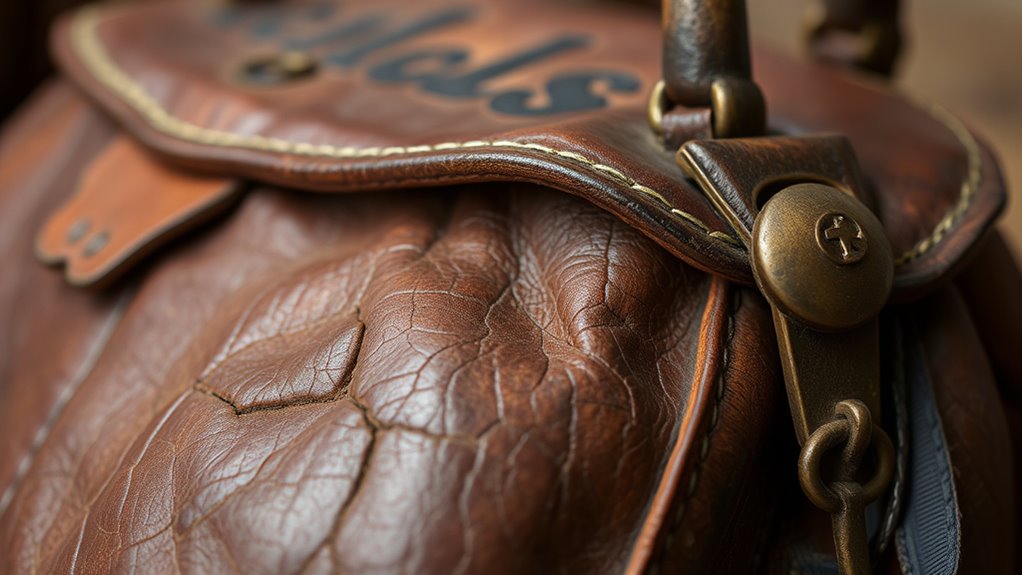
How does the age and rarity of your bag influence its value and repair options? If your bag has vintage charm or is a limited edition, its rarity preservation becomes essential. Older bags often hold more sentimental and monetary value, making careful restoration worth considering. Rarity can also mean that finding authentic replacement parts is difficult, so repairing rather than replacing helps maintain its uniqueness. Additionally, understanding Relationships – Personality Test traits can help you assess how much emotional attachment you have to the piece, guiding your decision-making process. Conversely, if your bag is common or heavily worn, the cost and effort of restoration might outweigh the benefits. Ultimately, understanding its age and rarity guides you in deciding whether professional repair will preserve its historic charm or if replacement is a more practical choice. Your decision hinges on protecting the bag’s legacy while balancing value and feasibility.
The Quality of the Original Materials and Construction

The durability of the original materials plays a vital role in deciding whether to repair or replace. High-quality craftsmanship and precise stitching also influence how well a item holds up over time. When these elements are strong, repair might be the better, more cost-effective choice. Additionally, understanding the contrast ratio can help assess the longevity of the projector’s image quality, which is often linked to the overall build quality.
Durability of Original Materials
The durability of original materials largely depends on their quality and the craftsmanship involved in their construction. High-quality materials guarantee better material longevity, meaning your bag can withstand daily use longer. When the craftsmanship preservation is solid, seams and finishes stay intact, preventing early damage. Consider these factors that influence durability:
- Premium leather or fabric that resists wear and tear
- Tight, even stitching that maintains strength
- Coatings or treatments for water and stain resistance
- Reinforced stress points to prevent splitting
- Quality hardware that doesn’t corrode or break easily
If your bag’s original materials are top-notch, they’ll serve you well over time, making professional restoration a worthwhile investment to preserve its functionality and appearance.
Craftsmanship and Stitching Quality
While high-quality materials lay the foundation for durability, the craftsmanship and stitching quality determine how well your bag holds up over time. Expert stitching techniques ensure seams are strong and resilient, preventing tears and fraying. Pay attention to handbag motifs, as well-crafted motifs reflect meticulous handiwork. Poor stitching or uneven motifs signal compromised craftsmanship, making repairs costly or ineffective. Here’s a quick comparison:
| Aspect | Good Quality | Poor Quality |
|---|---|---|
| Stitching techniques | Tight, even, reinforced seams | Loose, uneven, frayed edges |
| Handbag motifs | Precise, symmetrical design | Irregular, inconsistent motifs |
| Overall construction | Solid, durable, well-finished | Weak, fragile, poorly assembled |
Choosing a bag with superior craftsmanship ensures your investment lasts longer.
Environmental Impact of Repairing vs. Disposing
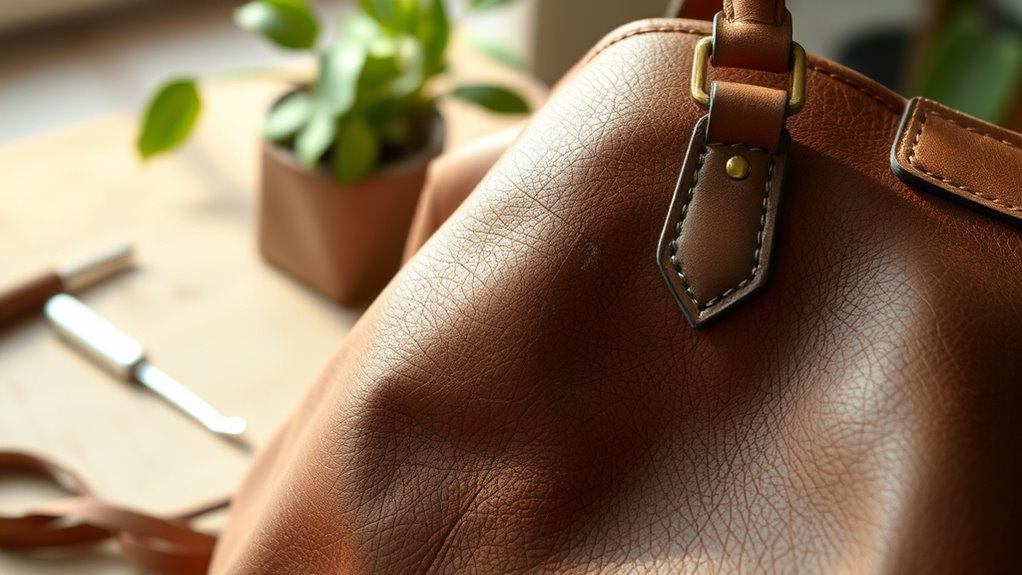
Deciding whether to repair or dispose of an item considerably impacts the environment, as each choice involves different resource consumption and waste generation. Repairing extends your bag’s life, reducing landfill waste and conserving resources. Using eco friendly practices and sustainable materials during restoration minimizes environmental harm. Conversely, disposing of a bag often leads to increased landfill waste, pollution, and the need for new resource extraction. Consider these factors:
- Repair reduces waste and conserves raw materials
- Disposal contributes to landfill overflow and pollution
- Restoring with sustainable materials lessens environmental impact
- Repairing lowers energy consumption compared to manufacturing new items
- Eco friendly practices promote long-term sustainability
- Incorporating professional restoration ensures quality and environmental responsibility
Your decision directly influences resource efficiency, pollution levels, and the overall ecological footprint of your bag’s lifecycle.
Tips for Choosing a Professional Restoration Service
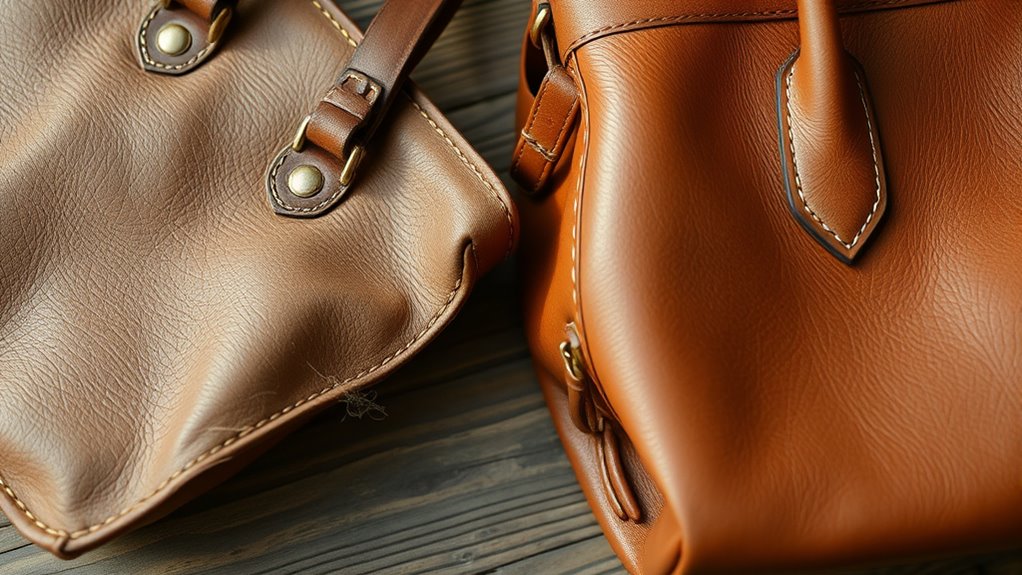
Choosing a professional restoration service requires careful consideration to guarantee your item receives quality care. Start by researching companies known for preserving vintage appeal, ensuring they understand the importance of maintaining originality. Check their brand reputation through reviews and testimonials, which can reveal their reliability and craftsmanship. Look for specialists experienced with similar items, as expertise directly impacts restoration quality. Ask about their process, materials used, and turnaround time to ensure they align with your expectations. A reputable service will offer transparency and a clear estimate upfront. Remember, the right choice can preserve your bag’s unique charm and value, so prioritize professionals with a proven track record in restoring vintage pieces while safeguarding their authenticity.
Frequently Asked Questions
How Long Does Professional Handbag Restoration Typically Take?
When you ask about how long professional handbag restoration takes, it’s important to contemplate the timing expectations for the repair process. Typically, restoration can take from a few days to a couple of weeks, depending on the bag’s condition and the extent of work needed. You’ll want to discuss your specific bag with the expert, who can give you a more precise timeline based on their repair process and workload.
What Are the Signs That a Bag Can’T Be Fully Restored?
Think of your bag like a cherished painting; some damage can’t be fixed. When material limitations prevent seamless restoration or if structural integrity is compromised, it’s a sign it can’t be fully restored. If the sentimental value outweighs the cost or effort, restoration might still be worth it. But if repairs won’t restore its original look or function, it’s time to contemplate replacing to preserve your investment.
Are There Specific Brands That Are Easier to Repair?
Some brands are easier to repair due to better brand compatibility and more accessible materials. For example, high-end designers like Louis Vuitton and Chanel often have skilled artisans familiar with their craftsmanship, making repairs smoother. Conversely, lesser-known brands or those with proprietary materials may pose challenges. You should consider repair ease when choosing a brand, as it impacts how straightforward and cost-effective professional restoration can be.
How Should I Prepare My Bag Before Sending It for Repair?
Before sending your bag for repair, start with cleaning tips to remove dirt and debris, guaranteeing it’s ready for work. Use gentle methods suitable for your bag’s material. Then, follow packaging precautions—wrap it carefully with bubble wrap or tissue to prevent further damage. Place it in a sturdy box, and include details about the repair needed. Proper prep helps ensure your bag arrives safely and is restored efficiently.
What Warranties or Guarantees Do Restoration Services Usually Offer?
They say, “A promise is only as good as the person who makes it.” When choosing restoration services, you should look for clear restoration warranties and service guarantees. Reputable professionals stand behind their work, offering warranties that cover repairs and craftsmanship. These guarantees give you peace of mind, ensuring your bag’s restoration is protected against future issues, so you can trust the quality and reliability of the service you receive.
Conclusion
Deciding whether to repair or replace your handbag depends on its sentimental value, condition, and craftsmanship. Did you know that restoring a high-quality vintage bag can extend its life by up to 20 years? By choosing professional restoration when appropriate, you not only preserve a piece of history but also reduce waste. So, weigh the costs and benefits carefully—sometimes, investing in repair is the smarter, more sustainable choice for your treasured bag.
